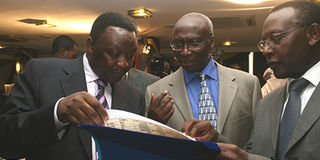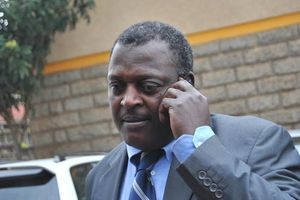Breaking: Autopsy reveals how Cyrus Jirongo died
Premium
Foreign power firms reap Sh6.2bn

Joseph Njoroge (left) Managing Director KPLC has a word with Patrick Nyoike (Centre) Permanent Secretary Ministry of Energy and Eddie Njoroge Managing Director Kengen after the power distributing firm announced its half year results on February 26,2010. PHOTO/ Liz Muthoni
What you need to know:
- KPLC declines to reveal local directors of private producers in windfall business
More than 50 per cent of the money Kenyans pay for electricity goes to foreigners and politically-correct individuals, the Sunday Nation has established.
Interviews with top officials in the energy sector revealed that Independent Power Producers (IPPs) and Emergency Power Producers (EPPs) – all owned by foreigners – have in the past eight months reaped Sh6.2 billion from Kenya.
And Kenyans will have to brace themselves for high electricity bills for the next two years.
However, the bills will come down significantly when the country starts generating more geothermal power.
The managing director of the Kenya Electricity Generating Company (KenGen), Mr Eddy Njoroge, told the Sunday Nation that geothermal power would bring down electricity charges by about 50 per cent.
The four firms that supply thermal power (generated using diesel) to Kenya Power and Lighting Company (KPLC) are all foreign-owned with unknown local directors.
The four companies include Iberafrica, OrPower 4 Incorporated, Tsavo Power Company and Aggreko.
While 20 per cent of Iberafrica is owned by KPLC’s pension scheme, the company is Spanish-owned through First Independent Power Kenya Consultants (FIPCK). Iberafrica is a subsidiary of a Spanish firm, Union Fenosa.
Orpower 4 Incorporated is registered at Cayman Islands and, according to the Public Investments Committee report, the company’s local directors are not known.
“But senior partners at Kaplan and Stratton, Samuel Wainaina and Ms Lin Auster, negotiated for the company when it commenced business in Kenya,” the PIC report states.
Another company, Tsavo Power Company Limited, is also a British firm but its local directors are not known.
Aggreko, which the government contracted last August to provide emergency power after the country was hit by a serious drought that led to the rationing of power, is also British-owned.
Efforts to establish the local directors of the firm hit a dead end as KPLC declined to reveal their identity.
“That question is best answered by the IPPs,” KPLC managing director Joseph Njoroge replied.
The KPLC boss was, however, quick to state that the foreign firms were responsible for high electricity bills because they were the only firms that could supply power to Kenyans.
“During the recent drought, power sold to KPLC from the cheaper hydro sources reduced to about 30 per cent and KPLC resorted to buying the more expensive thermal power from Independent Power Producers and Emergency Power Producers which increased the thermal percentage to 53 per cent,” Mr Njoroge said.
The contracts for Iberafrica and Orpower 4 Inc were signed when Mr Samuel Gichuru was the managing director of KPLC.
Another IPP which was retired in 2005, Westmont (K) Limited, was Malaysian owned.
Statistics from the Energy Regulatory Commission (ERC) show that since last September, Kenya has relied on the foreign firms to meet more than 50 per cent of its power demands.
The highest payments were witnessed in the four months of September, October, November and December last year when the four firms supplied an average of 58 per cent of power.
It also marked a period when power generated by KenGen through geothermal and its hydropower dams was at its lowest. The power-generating firm produced an average of 40 per cent of electricity.
During this period, Kenyans paid for fuel used to generate power by the IPPs and EPP.
The ERC director-general, Mr Kaburu Mwirichia, said Kenya procured the services of 280mw of power from EPPs in August 2009 but retired 40mw in December and a further 60mw last Wednesday.
But he was not promising any lower bills for Kenyans despite this reprieve, noting that the charges for March were yet to be tabulated.
“Masinga dam is yet to start generating because it is only 40 per cent full,” Mr Mwirichia added.
KPLC says it purchases power from various power generators and distributes and retails it to its customers.
The electricity firm is accused of sending high bills to its clients at a time when rains have been pounding the country for the last three months.
In February, many of the clients lamented that their bills had gone up by between 50 and 75 per cent. This prompted ERC to say that bills for subsequent months would come down with increase of hydropower generated electricity available.
In November 2008, the acting minister for Finance John Michuki promised Kenyans electricity would come down by 35 per cent after the government reduced taxes on energy and industrial fuels by four per cent.
But the reprieve for Kenyans was short-lived as, by July last year, charges for fuel were steadily growing from Sh5.39 to Sh6.16 in August. By September, the price had risen to Sh7.43.
Last week KPLC was not promising lower electricity charges for Kenyans noting that Masinga was only 40 per cent full while Turkwel was only 17 per cent full.
“Under normal hydrological conditions (normal rainfall) when dams are full of water, hydro power constitutes about 55 to 60 per cent of total power KPLC buys for retail to customers,” Mr Njoroge said.
He noted that the increase in thermal generated power led to the increased fuel cost charge paid by customers to refund suppliers of fuel used to generate power by IPPs and EPP and sold to KPLC for retail to customers.
Njoroge was, however, quick to add that the fuel cost charge is put in the power bill for convenience of collection and it is not income to KPLC.
KPLC noted that one of the lessons learnt during the 1999-2001 power-rationing period was that it was better to have expensive power than no power at all.
The firm was, however, reluctant to state how much it pays each of the IPPs and EPP, saying KenGen was better placed to know.




